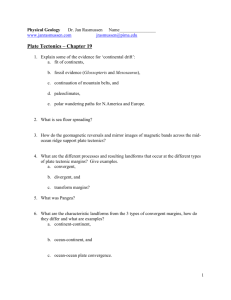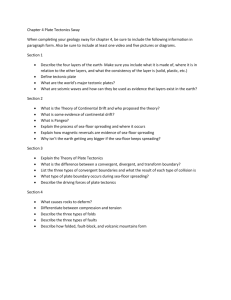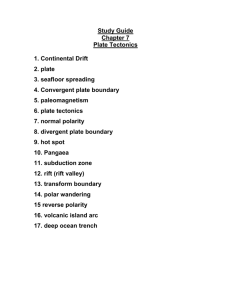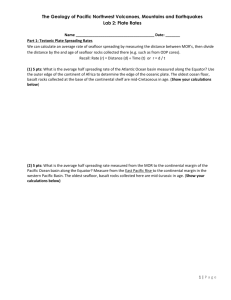GEOL 101 Lab 2: Plate Tectonics
advertisement
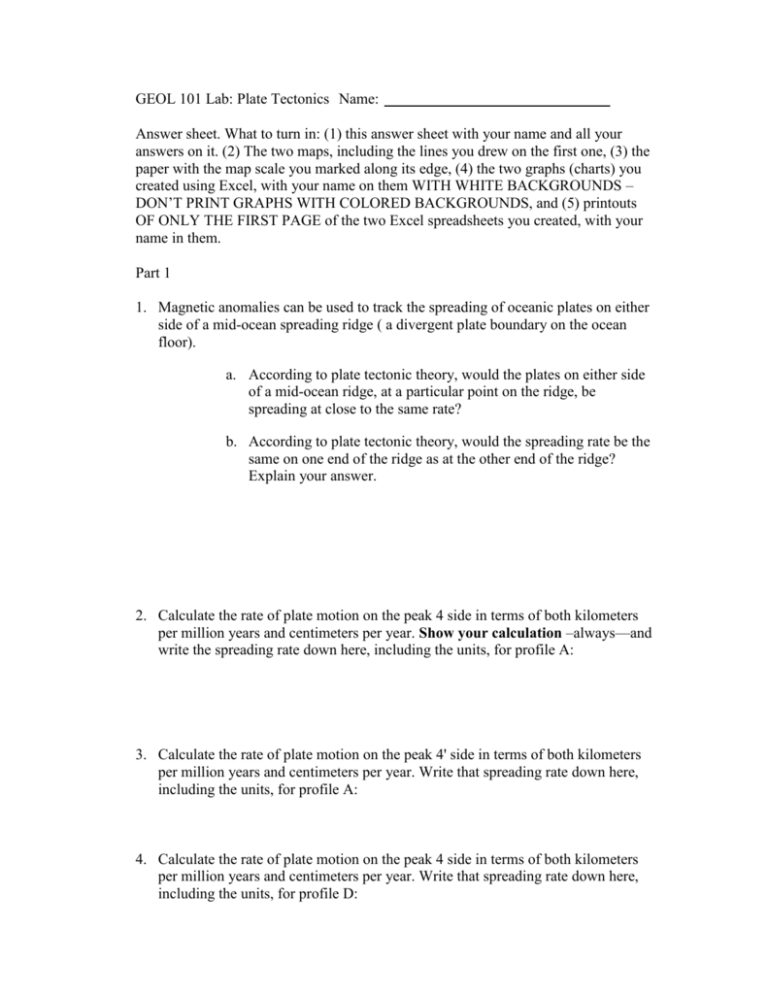
GEOL 101 Lab: Plate Tectonics Name: Answer sheet. What to turn in: (1) this answer sheet with your name and all your answers on it. (2) The two maps, including the lines you drew on the first one, (3) the paper with the map scale you marked along its edge, (4) the two graphs (charts) you created using Excel, with your name on them WITH WHITE BACKGROUNDS – DON’T PRINT GRAPHS WITH COLORED BACKGROUNDS, and (5) printouts OF ONLY THE FIRST PAGE of the two Excel spreadsheets you created, with your name in them. Part 1 1. Magnetic anomalies can be used to track the spreading of oceanic plates on either side of a mid-ocean spreading ridge ( a divergent plate boundary on the ocean floor). a. According to plate tectonic theory, would the plates on either side of a mid-ocean ridge, at a particular point on the ridge, be spreading at close to the same rate? b. According to plate tectonic theory, would the spreading rate be the same on one end of the ridge as at the other end of the ridge? Explain your answer. 2. Calculate the rate of plate motion on the peak 4 side in terms of both kilometers per million years and centimeters per year. Show your calculation –always—and write the spreading rate down here, including the units, for profile A: 3. Calculate the rate of plate motion on the peak 4' side in terms of both kilometers per million years and centimeters per year. Write that spreading rate down here, including the units, for profile A: 4. Calculate the rate of plate motion on the peak 4 side in terms of both kilometers per million years and centimeters per year. Write that spreading rate down here, including the units, for profile D: 5. Calculate the rate of plate motion on the peak 4' side in terms of both kilometers per million years and centimeters per year. Write that spreading rate down here, including the units, for profile D: 6. Are the spreading rates similar on both sides of the ridge? 7. Are the spreading rates the same on profile A as they are at profile D? 8. If the spreading rates are different at A and D, why? 9. Are the magnetic anomaly profiles perfectly complete? 10. Do you think that a meaningful analysis of the data was possible even though there were gaps in the data? Why or why not? 11. Are the lines connecting the profiles parallel to each other? Are they parallel to the ridge? 12. As far as this analysis goes, is it consistent with the theory of seafloor spreading? If not, in what way is it not? Part 2 13. On the map, what is represented by the dark, straight lines that mark offsets in the magnetic anomaly patterns? 14. The theory of seafloor spreading, which is part of plate tectonics theory, predicts that plates spread away from divergent plate boundaries at close to equal rates on either side of the ridge. If that is true for the Juan de Fuca Ridge, then the two lines on your graph should be more or less on top of each other. Are they? 15. If they are not, do you think it is because the plates have not been spreading symmetrically, or do you think it might be largely due to uncertainties in your measurements due to complicating factors such as the faults that offset the magnetic anomalies? 16. To the nearest 0.1 cm/yr, at what rate has the Pacific Plate been spreading away from the Juan de Fuca Ridge over the last 9.7 Ma? (The Pacific Plate is the plate on the west side of the ridge.) 17. To the nearest 0.1 cm/yr, at what rate has the Juan de Fuca Plate been spreading away from the Juan de Fuca Ridge over the last 9.7 Ma? (The Juan de Fuca Plate is the plate on the east side, or right-hand side, of the ridge.) Part 3 18. Give an explanation of why the Emperor seamount chain is oriented differently (as seen on a map) from the Hawai‘ian island/seamount chain. 19. Not all the data points on your graph fall onto a single straight line. Does this prove that the Pacific Plate is not really moving across the hot spot? Why or why not? 20. Give a plausible explanation of why some of the data points on your graph are scattered above and below each other, rather than spread out on a single line. 21. What does the slope of the line correspond to? (Slope is rise over run, or Y value divided by X value. Look at the Y units and divide them by the X units. What do you call the result?) 22. Assume that the graph portrays the rate of motion of the Pacific Plate across a stationary Hawai‘ian hot spot. If so, has the Pacific Plate always moved at a constant speed? (In other words, is the slope of the line constant?) 23. At what interval of time is the slope of the graph steepest? (In other words, at what interval of time would the Pacific Plate have been moving the fastest across the hot spot?) 24. Suggest an independent method of measuring the velocity of motion of the Pacific Plate, which could be used to compare with the rate of motion determined here by the Hawai‘i-Emperor volcano age-distance data.

